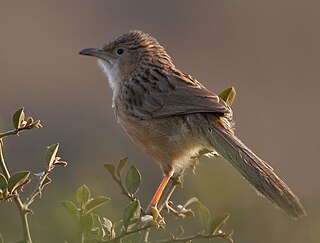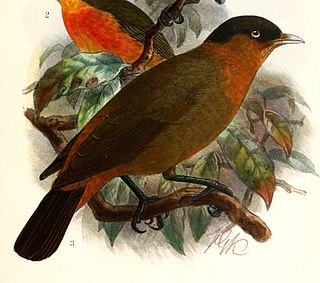
The orange-billed babbler also known as Ceylon rufous babbler or Sri Lankan rufous babbler is a member of the family Leiothrichidae.

The rufous babbler is an endemic species of bird found in the Western Ghats of southern India of the family Leiothrichidae It is dark brown and long tailed, and is usually seen foraging in noisy groups along open hillsides with a mixture of grass, bracken and forest.

The common babbler is a member of the family of Leiothrichidae. They are found in dry open scrub country mainly in India. Two populations are recognized as subspecies and the populations to the west of the Indus river system are now usually treated as a separate species, the Afghan babbler. The species is distinctly long-tailed, slim with an overall brown or greyish colour, streaked on the upper plumage and having a distinctive whitish throat.

Turdoides is a genus of passerine birds in the laughingthrush family Leiothrichidae. The species are distributed across Africa and southern Asia and are typically fairly large, long-tailed birds which forage in noisy groups. The majority of species have drab brown or grey-brown plumage. Several species that were included in Turdoides in the past have been reassigned to Argya following a 2018 study that found multiple clades.
The Tibetan babax is a species of bird in the family Leiothrichidae. It is endemic to China. It is threatened by habitat loss.

The Wayanad laughingthrush is a species of laughingthrush in the family Leiothrichidae. It is endemic to the Western Ghats south of Goa in India. These laughingthrushes move in groups in dense forests, producing loud calls but tend to be hard to spot in the undergrowth. They have brown upperparts, a white throat, a broad black mask through the eye and a heavy bill with pale yellow on the lower mandible. Despite the name, derived from the Wayanad region, this species has a wider range than the four other south Indian species of laughingthrush that are restricted to the higher elevation hills.
Chapin's babbler or Chapin's mountain-babbler, is a species of passerine bird in the family Leiothrichidae. It is endemic to the Democratic Republic of the Congo. Its natural habitat is subtropical or tropical moist montane forests. It is threatened by habitat loss.
The white-throated mountain babbler is a passerine bird in the family Leiothrichidae. It is found in Cameroon and Nigeria. Its natural habitat is subtropical or tropical moist montane forests. It is threatened by habitat loss.

The red-collared babbler, also known as the red-collared mountain-babbler, is a passerine bird in the family Leiothrichidae. It is found in Burundi, Democratic Republic of the Congo, Rwanda, and Uganda. Its natural habitat is subtropical or tropical moist montane forests. It is threatened by habitat loss.

The capuchin babbler is a species of bird in the family Leiothrichidae.

The Iraq babbler is a species of bird in the family Leiothrichidae, native to reed beds of the Tigris-Euphrates Valley. It is found in Iraq and south-western Iran.

The scaly chatterer is a species of bird in the family Leiothrichidae. It is also known as the bare-eyed babbler. It is found in Ethiopia, Kenya, Somalia, and Tanzania. Its natural habitat is subtropical or tropical dry shrubland.

The striated babbler is a species of bird in the family Leiothrichidae. It is found in southern Asia from Pakistan to Myanmar.

The fulvous babbler or fulvous chatterer is a species of bird in the family Leiothrichidae. It is 25 cm long with a wingspan of 27–30.5 cm. It is warm brown above with very faint streaking on the crown and back. The throat is whitish and the rest of the underparts are pale brown.

The white-throated babbler is a species of bird in the family Leiothrichidae. It is endemic to Myanmar.

The slender-billed babbler is a species of bird in the family Leiothrichidae. It is found in Bangladesh, Nepal, Northeast India and possibly Myanmar. Its natural habitat is subtropical or tropical seasonally wet or flooded lowland grassland. It is threatened by habitat loss.

The rufous chatterer is a species of bird in the family Leiothrichidae. It is found in Ethiopia, Kenya, Somalia, Sudan, Tanzania, and Uganda. Its natural habitats are dry savanna and subtropical or tropical dry shrubland.

Argya is a genus of passerine birds in the family Leiothrichidae. The species are distributed across Africa and southern Asia and are typically fairly large, long-tailed birds that forage in noisy groups. Members of this genus were formerly placed in the genera Turdoides and Garrulax.

The laughingthrushes are a family, Leiothrichidae, of Old World passerine birds. They are diverse in size and coloration. These are birds of tropical areas, with the greatest variety in Southeast Asia and the Indian subcontinent. The entire family used to be included in the Old World babbler family Timaliidae.

Ianthocincla is a genus of passerine birds in the family Leiothrichidae.

















